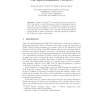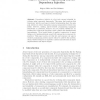SIGOPSE
2004
ACM
14 years 10 months ago
2004
ACM
The architecture of an operating system, e.g. micro kernel or monolithic kernel, is usually seen as something static. Even during the long lasting evolution of operating system co...
CSCW
2004
ACM
14 years 10 months ago
2004
ACM
Mission critical applications and legacy systems may be difficult to revise and rebuild, and yet it is sometimes desirable to retrofit their user interfaces with new collaborative...
RISE
2005
Springer
14 years 10 months ago
2005
Springer
Design by ContractTM is commonly cited as an example of the “crosscutting” concerns that aspect-oriented programming can address. We test this conjecture by attempting to imple...
GPCE
2005
Springer
14 years 10 months ago
2005
Springer
Aspect-oriented programming (AOP) is gaining popularity as a new way of modularising cross-cutting concerns. The aspectbench compiler (abc) is a new workbench for AOP research whi...
ECOOP
2005
Springer
14 years 10 months ago
2005
Springer
Abstract. Dependency injection is a hot topic among industrial developers using component frameworks. This paper first mentions that dependency injection and aspect-oriented progr...
ECOOP
2005
Springer
14 years 10 months ago
2005
Springer
Advice is a mechanism used by advanced object-oriented and aspect-oriented programming languages to augment the behavior of methods in a program. Advice can help to make programs m...
VEE
2005
ACM
14 years 10 months ago
2005
ACM
Language mechanisms deserve language implementation effort. While this maxim has led to sophisticated support for language features specific to object-oriented, functional and lo...
SAC
2005
ACM
14 years 10 months ago
2005
ACM
More and more software projects are using COTS (Commercialoff-the-shelf) components. Using COTS components brings both advantages and risks. To manage some risks in using COTS com...
KBSE
2006
IEEE
14 years 11 months ago
2006
IEEE
Aspect-Oriented Programming (AOP) has been proposed in literature to overcome modularization shortcomings such as the tyranny of the dominant decomposition. However, the new langu...
ICSM
2006
IEEE
14 years 11 months ago
2006
IEEE
One of the main promises of aspect-oriented programming (AOP) is to promote improved modularization of crosscutting concerns, thereby enhancing the software stability in the prese...



